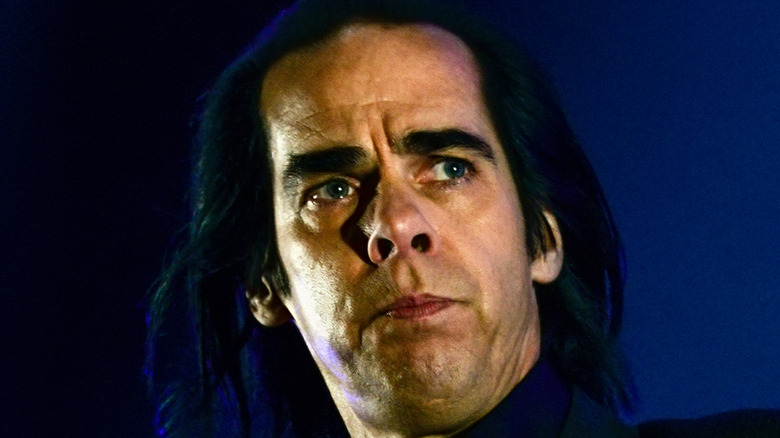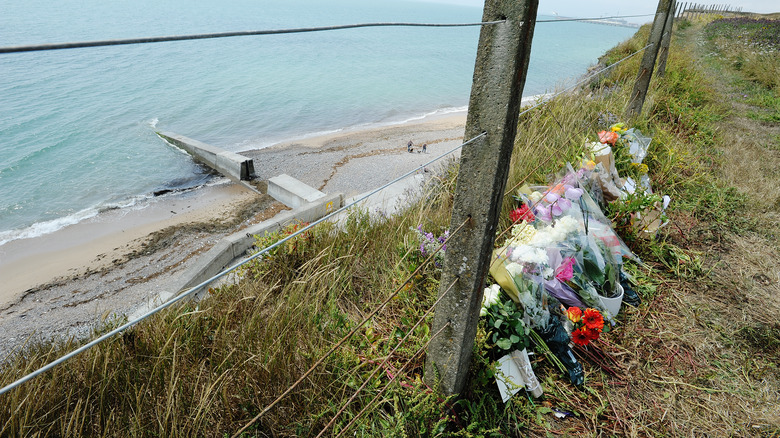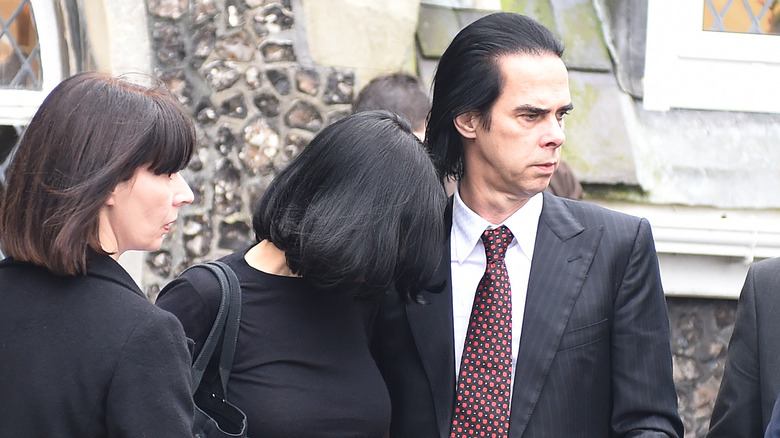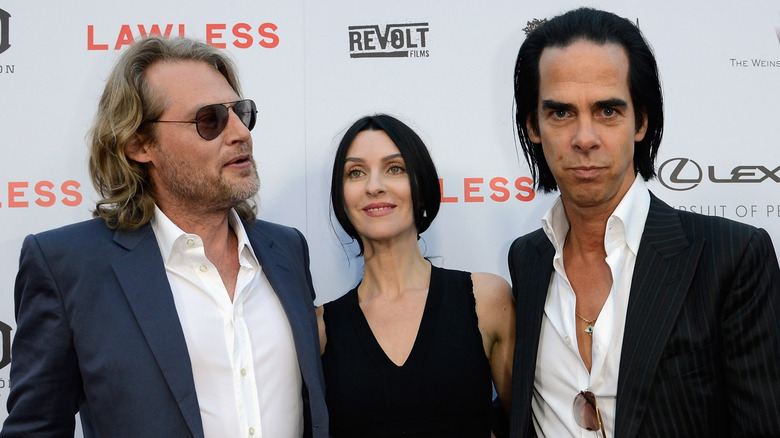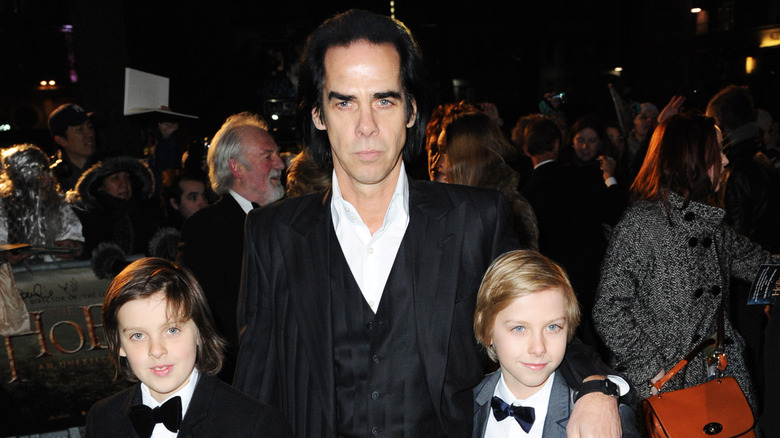The Tragic 2015 Death Of Nick Cave's Son
"It's hard to know what to say that is helpful. People often say they can't imagine how it would feel to lose a child, but, actually, they can -– they can imagine what it is like." Revered Australian singer-songwriter Nick Cave shared those words with The Guardian following the tragic death of his 15-year-old son Arthur in 2015. Anyone who watches "Peaky Blinders" may recognize Cave's booming, menacing voice presiding over the intro track "Red Right Hand" that's become a daunting staple of the show, but his listenership and fanbase had grown vast and worldwide long before "Peakys" ever aired.
Devout fans stood by their hero as he endured the greatest tragedy of his life, arranging a fundraiser for the singer and his family following their excruciating loss. "Nick Cave's writing and music has undoubtedly shaped the lives of many thousands of people throughout the world and, although we don't know him personally, it feels right to show support to him and his family at what we can only imagine must be an unthinkably painful time," said Andrew Fenwick, fundraiser co-founder and dedicated fan (via The Argus). Since then, Nick Cave has channeled grief, confusion, and redemptive healing into art and various philanthropic endeavors.
A fatal fall
On July 14, 2015, 15-year-old Arthur Cave and a friend of his were walking along the ledge of a cliff in Brighton, England that towered above a vast stretch of beach before the Ovingdean Gap. Witnesses recall seeing the young man staggering about a grassy area atop the cliff before falling to his death onto the underpass below minutes later. An unnamed jogger observed the boy lying on the pavement and contacted authorities immediately. Paramedics arrived and rushed Arthur to Royal Sussex County hospital where doctors began treating him for critical brain injuries. Though the initial impact of the fall didn't kill him, Dr. Paul Ransom soon discovered that nothing could be done to salvage his life, and Arthur Cave was pronounced dead at 7:08 p.m. that evening (per The Guardian).
Dr. Simi George, who carried out the postmortem examination, later declared in a public statement: "In my opinion, even if there was a trauma team at the bottom of that cliff it would have been very unlikely that he would have survived." It was also discovered that Cave and a friend had ingested the hallucinogen LSD earlier in the day and Arthur became disoriented. The coroner said the LSD was a "contributory factor" leading to his fatal fall, according to Huffington Post UK.
The aftermath of Arthur's death
Following their son's tragic passing, Nick Cave and his wife Susie Bick attended a legal inquest into Arthur's death accompanied by police and representatives from the local coroner's office. The couple made a statement shortly after through Sussex police declaring, "He was our beautiful, happy, loving boy" (per Huffington Post UK). After the fact, Nick Cave moved with his wife to Los Angeles in an attempt to distance themselves from the painful memory of what happened on that awful day in July.
"Brighton had just become too sad," Cave told a fan through his Q&A site Red Hand Files in 2021. "We did, however, return once we realized that, regardless of where we lived, we just took our sadness with us. These days, though, we spend much of our time in London, in a tiny, secret, pink house, where we are mostly happy" (via NME). Though he is more transparent toward the subject as of late, Nick Cave's first official remarks about Arthur's death didn't come until 2016 when he appeared in director Andrew Dominik's film "One More Time with Feeling," a visually spellbinding documentary detailing the recording process of Cave's critically acclaimed album "Skeleton Tree" (per NME).
Channelling pain into art
Vivid, entrancing, and almost ethereal in tone, Andrew Dominik's "One More Time with Feeling" (2016) endeavors to unpack the folds of melancholia that enraptured Nick Cave's art following the death of his son. Shot mostly in a studio setting, the scenes are captured through 3D cameras and appear in black and white with emphasized lighting effects that grant the film an otherworldly aura. The collaborative techniques between Cave and producer/fellow musician Warren Ellis on "Skeleton Tree" are the bulk of the project's subject matter, but personal conversations with the "Mercy Seat" singer and his wife Susie Bick about their late son are showcased throughout as well (per Nick Cave).
"Things have been torn apart. And I'm desperately trying to find a way of making some kind of narrative sense out of it — if we're talking about songwriting — or at least some sense out of it." Nick Cave explained in an exceptionally vulnerable moment of reflection later on in the film (via IMDb). Elaborate statements like this were the first real, in-depth recollections of the tragedy that Cave and Bick discussed openly through a public medium. In 2022, Andrew Dominik released a new Nick Cave/Warren Ellis-based documentary entitled "This Much I Know to be True" which premiered at Austin's South by Southwest festival in March (per Collider).
'The nature of Grief'
"In time, there is a way, not out of grief, but deep within it," Nick Cave explained in 2020 (via NME). "Susie and I have learned much about the nature of grief over recent years. We surrendered to something over which we had no control, but which we refused to take lying down." The suffering he and his family have endured has admittedly been nearly insurmountable, but it would seem that redemption and atonement with circumstances beyond one's control are never out of reach.
Naturally, much of the sentiments that arose from the loss of his son became contingent upon Cave's songwriting process. "Girl in Amber," a popular track off "Skeleton Tree," was written as an homage to Arthur and evokes how the artist managed to heal after his death. Cave described it as "wrapped around a mystery. It is a song that formed itself as if from a dream and it seems to possess a special, almost mystical, power" (per Far Out Magazine).
Nick Cave heals with help from his fans
Remarkably, Cave has welcomed his fans into his healing process on a deeply personal level and has not shied away from their inquiries or concerns. He told Mark Mordue during a 2017 interview with The Guardian, "A lot is said about grief, especially the conventional wisdom that you do it alone. I personally have found that not to be the case. The goodwill we received after Arthur's death from people who I did not know, especially through social media, people who liked my music and kind of reached out, was extraordinary."
The Red Hand Files has become a popular online Q&A medium through which he readily communicates with his fans and responds to comments and letters firsthand. In December of 2019, a woman from California posted on the site about her mother who was murdered in cold blood by an active shooter, asking Nick Cave for advice on how to recover from resentment and loss. He concluded his extensive and empathetic response with, "There is another place too, a quieter place that patiently awaits you, and maybe in time you will find a moment to temporarily lay down the sword and, speaking into the sacred silence, talk to your mother, in grief, in longing, and in her presence, and perhaps find some solace there. I very much hope so. Love, Nick."
